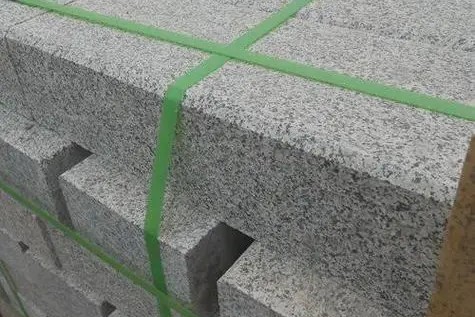Granite chamfering is a fundamental process in the fabrication and finishing of granite surfaces, helping to enhance safety and aesthetics. This article aims to explore the principles and methods of granite chamfering and reveal the advantages and technical approaches of this key technology.
Principles and Methods of Chamfering
Chamfering principle: enhance safety and aesthetics
Beveling is the process of blunting or removing the edges of granite to create a rounded edge effect. The main benefit of chamfering is its ability to remove sharpness or angularity from granite edges, thereby minimizing the risk of injury to the human body. In addition, chamfers enhance the beauty and decorative effect of granite, creating a sleek and modern look while ensuring safety and comfort.
Chamfering methods: manual and machine technology
There are many technical methods for chamfering granite, among which manual chamfering and machine chamfering are the most commonly used methods. Manual chamfering refers to workers using a chamfering polisher and polishing pad to manually polish and trim the edges of granite, achieving the ideal chamfering effect through skilled craftsmanship. Machine chamfering, on the other hand, utilizes specialized granite edge levelers to trim and cut granite edges, achieving precise and consistent chamfering results through an automated process.
Versatile Applications of Chamfering Technology in Granite Processing
Chamfering technology plays a key role in the machining and finishing of granite, offering a wide range of applications in various industries and design elements.
1. Enhance the beauty and practicality of home decoration
In the field of home decoration, chamfering technology is widely used in granite countertops, washbasins, wall and floor tiles, and various decorative elements. By blunting or removing granite edges, bevels enhance the beauty and functionality of granite surfaces, helping to create a sleek, modern look while prioritizing safety and comfort. The rounded edge effect achieved through chamfering not only eliminates sharpness or angularity but also enhances the overall decorative effect of granite, making it an indispensable technology in home interior design.
2. Reduce the risk of building decoration injuries and improve safety
In architectural decoration, chamfering technology is mainly used in door and window corners, stair steps, and various building components to reduce the risk of injury to the human body during impact. By blunting the edges of granite surfaces, chamfers help protect the safety and well-being of the occupants, minimizing the potential hazards caused by sharp edges. This application of chamfer technology emphasizes its role in enhancing the safety and comfort of the built environment, making it an important technology in building design and construction.
3. Create rounded and vivid stone sculptures
In the field of stone carving, chamfering technology plays a vital role in creating rounded and vivid stone carvings, allowing natural stone to present different shapes and contours. By utilizing chamfering techniques, stone sculptures can achieve a more organic and realistic appearance, contributing to the artistic and aesthetic value of stone sculptures and architectural elements. The use of chamfering techniques in stone sculpture highlights its versatility and ability to enhance the visual impact of granite and other natural stones.
In summary, chamfering technology is widely used in granite processing, spanning home decoration, architectural decoration, stone carving, and other fields. By blunting or removing granite edges, chamfers enhance the aesthetics, practicality, and safety of granite surfaces, helping to create a visually striking and safe environment in a variety of applications. Whether in residential, commercial, or artistic settings, chamfering techniques play a key role in enhancing the overall quality and visual appeal of granite and natural stone.
Limitations of Granite Chamfers
The application of chamfering technology in granite processing has completely changed the way granite surfaces are processed and utilized in various industries. However, although chamfering technology has many advantages, it also has certain limitations and challenges in actual production.
1. Efficiency and effectiveness of manual chamfering
One of the limitations of granite beveling is the efficiency and effectiveness of hand beveling, especially when working with larger granite surfaces. Manual chamfering can be inefficient and may not always achieve the desired results, especially when applied to larger pieces of granite. The labor-intensive nature of manual chamfering can result in increased production time and cost, which poses a challenge in achieving consistent and high-quality chamfered edges on larger granite surfaces.
2. Technical skills and energy consumption of mechanical chamfering
Machine chamfering, while offering potential advantages in terms of accuracy and consistency, also has limitations in terms of energy consumption, cost, and the technical skills required of the operator. The operation of a professional granite edge leveler requires a high level of technical expertise and the energy consumption associated with machine chamfering results in increased production costs. Additionally, the initial investment in advanced machinery and training of skilled operators can present challenges for businesses looking to adopt machine-chamfering technology.
Advances and Possibilities in Granite Processing
Despite the limitations of granite chamfering, the continuous advancement of mechanical technology and stone processing technology provides ample possibilities for the decoration and application of granite. As technology continues to evolve, it will be possible to develop more efficient and cost-effective machine chamfering solutions that address challenges related to energy consumption and technical skills. In addition, advances in automation and robotics in stone processing may provide new opportunities to simplify and optimize the chamfering process, increase efficiency, and reduce production costs.
Balancing Limitations with Innovation and Progress
In conclusion, the limitations of granite chamfering highlight the challenges and opportunities inherent in the application of chamfering technology in stone processing. While manual and machine chamfering present challenges in terms of efficiency, cost, and technical skills, continued advances in technology offer the potential for innovation and advancement in the field of granite processing. By balancing these limitations with continued innovation and technological advancement, the industry can overcome challenges and unlock new possibilities for efficient and effective application of chamfering technology in granite processing.
Post time: Jun-07-2024

